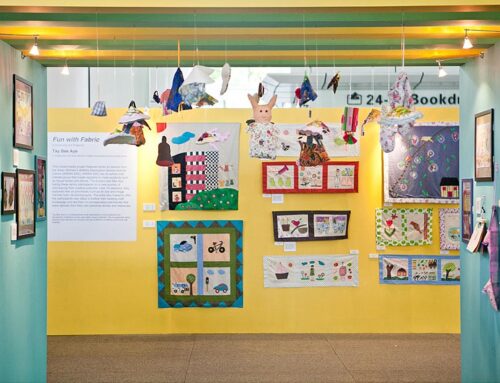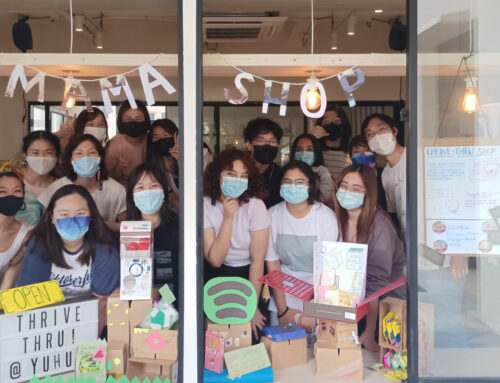Library / Field Studies
Crafting Spaces of Agency, Solidarity and Resilience
Library / Field Studies
Crafting Spaces of Agency, Solidarity and Resilience
By Regina De Rozario
14 June 2024
While the arts have been said to produce transformative benefits for those who facilitate and participate in this field, a fuller sense of how artistic processes contribute towards a community’s developmental goals may still be unclear. In turn, this lack of clarity may affect how arts-based community work can be locally supported, prioritised and sustained. In the first of this two-part series of articles, guest contributor Regina De Rozario reflects on points raised at the inaugural ArtsWok Learning Forum held on 29-30 March 2024 and synthesises her personal takeaways from the first day’s panel in respect to this question.
The Place of Artists in Community Development Work
“When I first saw the social media post about this Learning Forum, I found it very arty; very different from the usual conference materials and that made me curious… and so I signed up, and I’m here today with my colleagues.” This remark, paraphrased, was offered by a woman seated next to me at the Black Box theatre at Goodman Arts Centre. We were engaged in conversation during ArtsWok Collaborative’s inaugural Learning Forum, a two-day event that involved panels, workshops, and other discussion activities built around the theme of ‘Developing Community Creatively’. The forum was attended by over 140 participants from the arts, education, social work, and public health, as well as government officers and funders who intersected with and bridged these areas.
My neighbour for that morning’s programme described her work as ‘community care’, in service of families who were in need. Upon learning that I was an artist, she admitted that she had little experience in the arts but was generally appreciative of what artists have done with and for communities, even though she was unsure what this was exactly. Her interest and enthusiasm were echoed by several other attendees I spoke to. Those who were new to arts-based approaches said they wanted to learn more about it, and to see if there were any ideas that could be useful for their programmes.
In comparison, my conversations with artists like myself revolved around matters of labour, time and resources. On the one hand, these artists said that they recognised the growing interest by organisations to engage them in a myriad of roles and responsibilities, such as creative programming, curation, production design, and participant facilitation. At times, an artist may even perform all of these roles at different stages of a given project. This is often the case when the project is initiated and driven by artists themselves who seek to do something connective and meaningful in the spaces they inhabit. In this sense, these projects provide artists with valuable opportunities to expand their artistic practice and to deepen their understanding of particular communities.
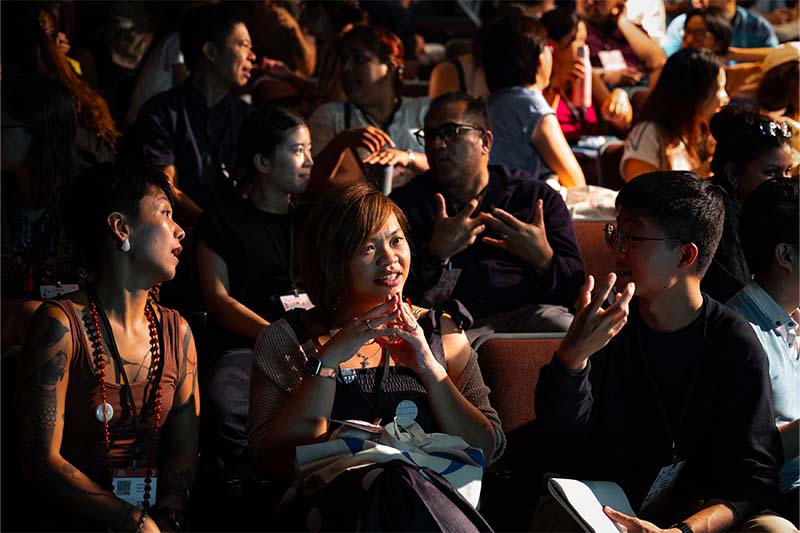
One of the highlights of the inaugural ArtsWok Learning Forum was the opportunity to meet and connect with emerging and established practitioners from across different sectors, such as the arts, education, health, social sciences, philanthropy and public service. In addition to the panels and workshops, attendees could engage each other through icebreaker conversations held at the start of each day’s proceedings. Photo by Zinkie Aw.
Broadly, to engage in arts-based community development work is to adopt a strategic approach that integrates the arts into a community’s planning and development initiatives. For example, an art project could be developed based on the community’s existing interests and abilities to address issues such as neighbourly cohesion and cooperation, the revitalisation of shared community spaces, and the boosting of community-based employment and economies.1
It follows then that there are certain characteristics of community development work – such as its complexity and unpredictability – that require artists to be constantly engaged, attuned and responsive to the needs and ideas of community members. However, tactics that work in one context may not necessarily work in another.2 Furthermore, artists need to understand and be clear about their own place within the gamut of developmental work, which tend to also involve multiple funding bodies, social service organisations, intermediaries and other project partners. One artist I spoke to described himself as “grateful to be doing meaningful work, but exhausted” by the plethora of administrative and “miscellaneous” tasks that he was involved in on top of actual artistic direction and personalised facilitation with community members. He added that he was unsure what these tasks were for but that it felt like “more than full-time work, but without full-time compensation”. Because of this, he said he was interested to hear from others at the forum and learn how he might conduct his practice more sustainably.
These brief exchanges with other participants at the forum stirred several questions that I had been thinking about in relation to my own research and observations about locally situated artistic practices and community work: What exactly is the artist’s place within a community project? What constitutes artistic labour and processes? What can stakeholders (such as social or health workers, funders or community members themselves) expect from artists through their partnerships? To what extent can artistic processes serve community development goals? Also, could these goals include making space for artists and community members to work together in a sustainable manner?
Approaches to Art and Community Work
The first three questions, ‘What is the artist’s place within a community project?’, ‘What goes into artistic labour and processes?’ and ‘What can stakeholders expect from an artist?’ were broadly attended to by the three speakers in the forum’s first panel. Dubbed Exploring Potential Models of Long Term Practice for Arts-Based Community Development, the panel provided insights into their respective contexts and practices.
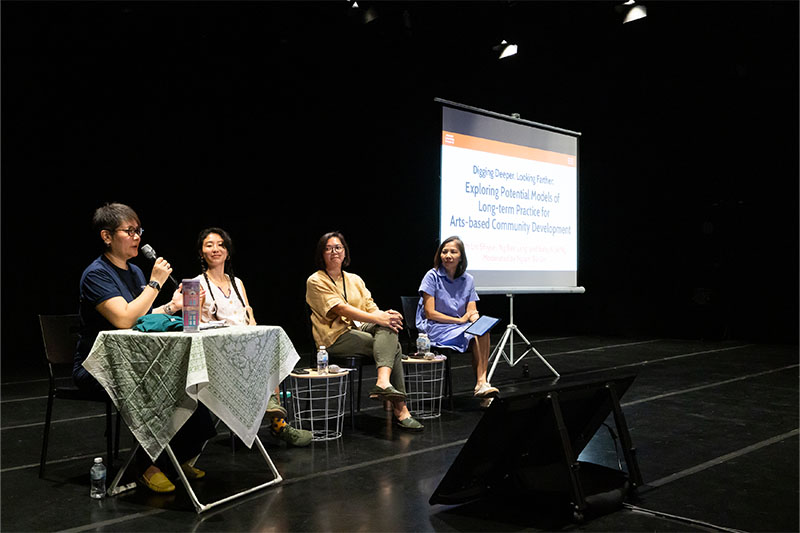
The first panel of the ArtsWok Learning Forum explored possible models of long-term practice for arts-based community development. Moderated by ArtsWok Collaborative’s executive director, Ngiam Su-Lin (left), it featured insights from Salty Xi Jie Ng, Lin Shiyun, and Ng Bee Leng (second from left to right) regarding their recent projects and respective approaches to working with communities. Photo by Zinkie Aw.
Ng Bee Leng, divisional director of strategy and transformation at Allkin Singapore, shared about her asset-based approach to community development. Foregrounding a ‘strengths-based mindset’, this approach focuses on uncovering the existing and potential strengths of community members and leveraging on these assets; enabling the needs and desired improvements of the community to be addressed from within the community itself.3 Foregrounding community strength became important when she noted changes in the way community members interacted and offered to help each other in spite of their own limited means. For example, where neighbours had been more forthcoming in pulling their resources together in the past, she began to see changes in communal behaviour as more professional social services came to the fore to ‘plug the gaps’ for disadvantaged communities. She further noted that while such services were offered with good intentions, this would inadvertently create a ‘deficit-based mindset’ within communities where members might develop a tendency to passively rely on external institutions for help.
For Bee Leng, a more balanced approach that begins with mapping the community’s own capabilities and expertise would be more constructive and generative. That is, to begin with the question “What can community members do well on their own?” before asking, “What can they do well with help?”
Such a mapping exercise, she emphasised, would need to be done with community members, not for them. This makes sense as it would enable community members to describe and recognise the assets and expertise in their midst and in their own terms. Furthermore, such an exercise would essentially invite and encourage members to take a more active stance in working together in several ways; such as to name their assets, agree on how they may be applied, and to leverage on their strengths to pursue communal goals. Over time, this helps to foster a sense of pride, trust, and shared responsibility around what the community can achieve on its own. In turn, what could emerge is a community-led space shaped by its own agency, solidarity and resilience.

A series of Field Lessons, held prior to the ArtsWok Learning Forum, enabled attendees to experience some of the featured community projects. Here, Camy (centre, facing camera), a multidisciplinary artist, speaks to attendees about how he applies creative approaches to community projects in Ang Mo Kio. His walkabout is just one of the thematic Resilience Trails by Skillseed, developed in partnership with Allkin Singapore, that engages directly with community members’ lived experiences and strengths. Residents such as Camy who join as Community Guides have the opportunity to acquire facilitation and guiding skills and supplement their income by co-creating and conducting narrative walks through their neighbourhood. Photo by Seah Sze Yunn.
Although Bee Leng did not address the role of arts or artists specifically in her presentation, it is not difficult to extrapolate and imagine how artistic modalities might fit within an asset-based community development framework. At the very least, an asset mapping exercise – which can be devised as a creative drawing and narrative activity – would likely uncover a number of community members with creative interests and skills in varying forms. This might even extend beyond the arts into ‘everyday’ practices where creativity may be imbued, such as cooking, caregiving and home improvement. The question of how these skills could be applied within a development project would depend on the aims of that project. If community members are unclear about how their creativity could be blended to meet their goals, their ideas could be nurtured in partnership with those outside of the community, such as artists and other creative intermediaries.
Lin Shiyun, founder and executive director of 3Pumpkins, echoed some of the points raised by Bee Leng. In particular, the importance of paying close attention to the collective creative strengths of a given community and knowing when to step aside for community members to take the lead. In describing her work with Tak Takut Kids Club, a social support group that engages young people from disadvantaged backgrounds in visual and performing art forms and other creative learning activities, she noted how its members were observed to be largely resilient, self-organising and full of ideas. What I understood from her sharing was that a level of co-creation could already be put into practice with these youths, in spite of their varied age groups and lived experiences. Members could discover new skills and learn about cooperation, problem-solving and persistence through scaffolded arts-based activities, for as long as they were curious, “tak takut” (Malay for “unafraid”), and felt supported by their peers. In this sense, Shiyun and her team were creative interlocutors who facilitated opportunities for these children and youth to take risks and have each other’s back should things fall through.

Tak Takut Kids Club, a project spearheaded by 3Pumpkins, provides space for children to “be unafraid”. They get to express themselves by organising and participating in creative activities, and learn cooperation and persistence by supporting each other’s endeavours and aspirations. Photo courtesy of 3Pumpkins.
In examining the Tak Takut Kids Club through the framework of community arts practice, one could observe and measure the impact of the project by gauging its members’ exposure to art forms and the development of their creative skills. As an approach for practice, ‘community arts’ is largely aimed at fostering a sense of community spirit, and in shaping an environment of active interaction, learning and cooperation. Activities tend to be participatory, and take place in familiar community settings with a focus on getting members to work together and engage each other through a creative process.4 At times, the activity may be about the aesthetic enhancement and transformation of a shared physical space; reframing the use of the space and renewing a sense of appreciation and responsibility for it.5 The activity may also be considered a pedagogical exercise, where artists (from within the community, or invited in) are able to model and impart the knowledge, skills and attributes associated with creative thought, agency, experimentation and expression.
Relatedly, Tak Takut Kids Club could also be evaluated through the frame of socially engaged art; to measure how the children and youth might feel supported and included through the different activities and within the spaces they have helped to create. While they might bear similar participatory and artistic characteristics, community arts and socially-engaged art foreground different aspects and aims. Unlike the community arts approach which often has a clear and tangible output at the end (such as a space, a performance, an exhibition), socially engaged art is process-oriented, and focused on enabling deep engagement with social issues through the art-making process.6 In these projects, participants such as community members themselves often feature as the medium or the subject material of the work, and thus are highly visible and present by way of narrating their own stories, by showcasing their personal artefacts, or by engaging in civic acts like running a community space or conducting walking tours.7 Further, they might work as a group over longer periods of time to converse, conceptualise and produce artworks that reflect their views on a given topic. Formats and processes of working are intentionally facilitated by the artist to initiate dialogue, to engage with different perspectives, to deepen understanding about a particular issue, and to drive some aspect of change within oneself, the group, or within a social situation.8
Expanding on this approach was the third panellist Salty Xi Jie Ng, an artist and educator, who spoke about her practice in social forms of art, and her involvement as lead artist of Both Sides, Now 2023-24 at Yishun. Similar to Bee Leng and Shiyun, Salty’s sharing emphasised the importance of paying attention to contexts and in developing an ‘ecology of relations’ with the participants and partners she encounters. Her sessions for the project included one-to-one conversations and facilitated group activities with eight senior women from Wellness Kampung@765 Nee Soon Central, revolving around Both Sides, Now’s signature theme of ‘Living Well, and Leaving Well’ and the importance of preparing oneself and one’s loved ones on matters related to death.9 Through their conversations, the group also made space beyond this thematic framing for their thoughts, emotions and reflections to take flight.
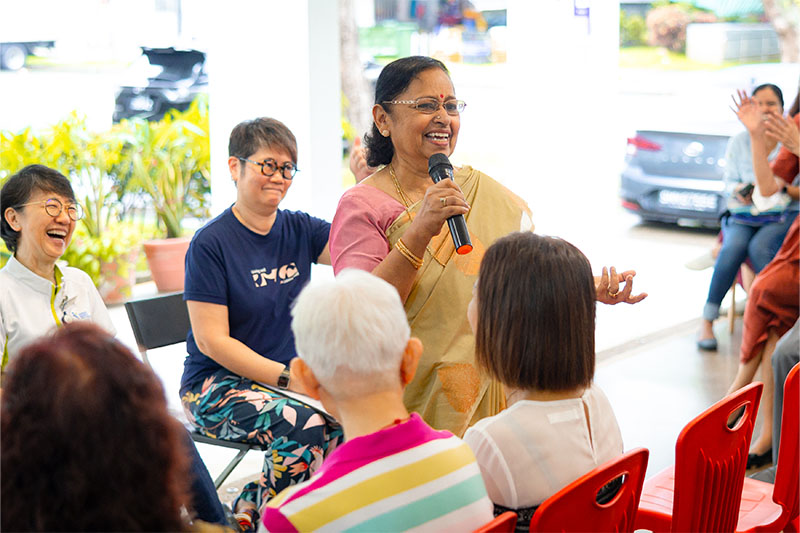
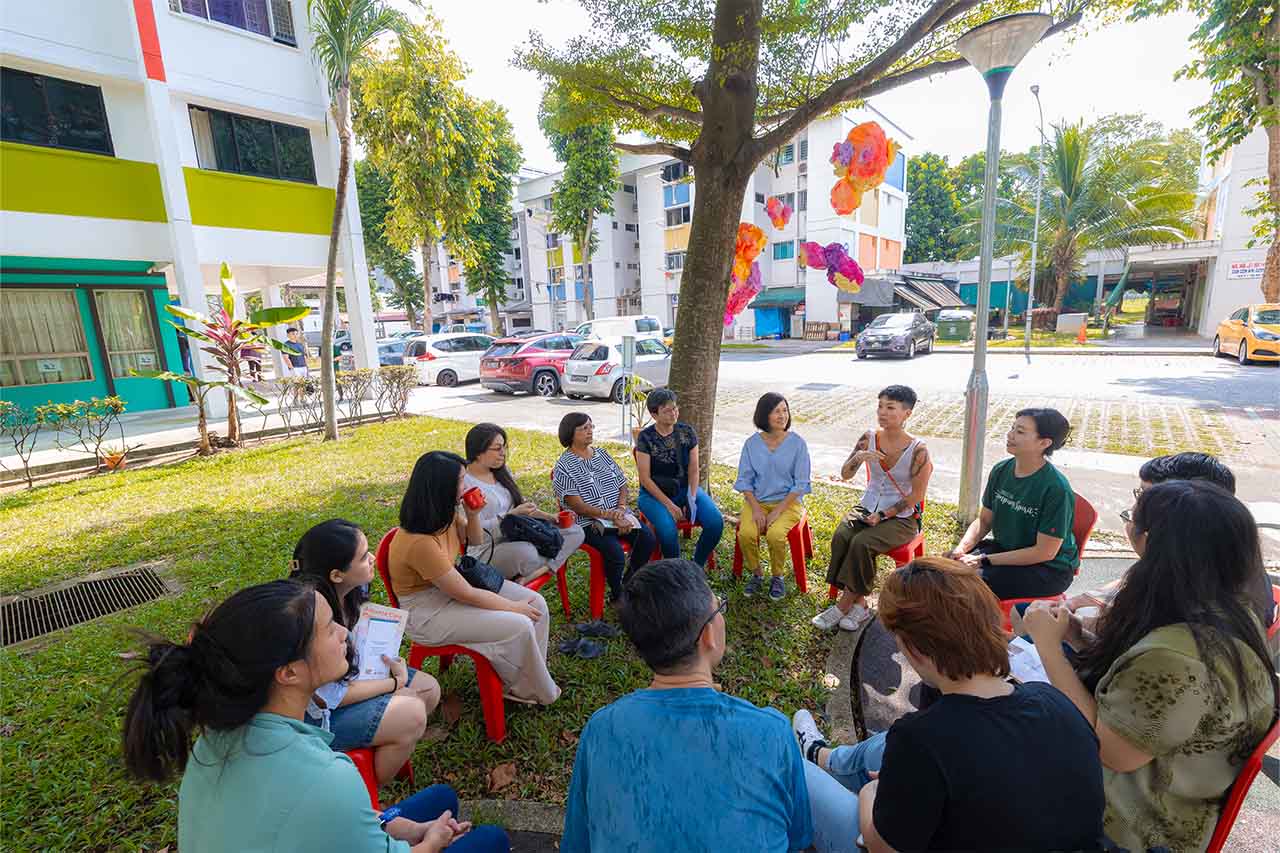
Public activities such as exhibition tours, panels and conversation circles were organised as a part of Both Sides, Now 2023-24. Led by the project’s senior collaborators such as Devi Maniam (top image, centre) and Agnes Tan (lower image, centre facing camera, in blue), these activities sought to engage a wider community of family members, fellow regulars from Wellness Kampung@765 Nee Soon Central, project stakeholders and members of the public in dialogue about end-of-life matters. Photos by Zinkie Aw.
As a part of the project, the group produced an exhibition and provided public tours of the audio and visual artefacts. This enabled the group to share an aspect of their process with an audience of vested partners, the wider community of participants’ families and neighbours, as well as other stakeholders who could help sustain and fund future endeavours. However, it is important to note that in social forms of art, what is crucial about the project is not the tangible output of an exhibition or performance but the time and space that is crafted jointly by participants to relay their thoughts, feelings, aspirations and choices. That is to say, the ‘work’ of art here is not the artefact. Rather, it is the act of being present, together.
Narrating Crucial Processes, Crafting Sustainable Community Spaces
At the core of arts-based community development work is the belief that the arts can play a vital role in fostering healthy communities. It is a tenet that applies regardless if a community has already established itself through a shared purpose, location or identity; or if it is still in the process of coming together. Whatever its phase of development, a community that integrates artistic approaches into its developmental strategies provides space for ideas, emotions and expressions to diverge, cross, and converge. Given time and support, such a community can become a resilient space imbued with a sense of pride, agency, and solidarity.
That said, the question I raised earlier – ‘To what extent can artistic processes serve community development goals’ remains a deeply contextual one that leads to other deeper lines of inquiry. Firstly, there is the query of what indicators might be most helpful in narrating the crucial processes that artists engage in with communities, especially when these processes are largely ‘hidden’ from others outside of the community. In most cases, the aesthetic artefacts and experiential learning outputs of a community project – whether in the form of art and craft work, an exhibition or performance, or even the mere presence of a dedicated long-term ‘arts space’ – tend to be its most recognisable and talked about aspects, even if they are not the most crucial, as explained in the earlier section. From my observations, these artefacts are turned to again and again as visible evidence; interpreted as signs of active community participation, vibrancy and cooperation, and measured in terms of attendance numbers, participant feedback and audience surveys. Together, these signs can be documented, articulated and promoted to further develop, raise funds, and sustain such projects. However, they tend to fall short in capturing the fullness of what an artist does ‘with community’ or how arts-based, relational processes actually help community members to cohere and want to work together.10
Secondly, what is also less frequently narrated is how immersive artist-led processes might creatively reshape and transform the work of community development itself. Have there been artists who have helped a community shape its goals? If so, how was this done? Despite the availability of case studies and project reports, it takes time and effort to interpret these highly contextualised narratives into transferable knowledge or methods for new projects. In other words, community projects – be they fresh initiatives with newly formed communities, or long-term endeavours with established groups; regardless of their state of development and complexity, hold much potential for qualitative research to understand the types of skills and capacities needed for the field. However, what is anecdotally understood is that research into artist-led processes tends not to be prioritised due to limited time and resources. This in turn creates other related issues such as the lack of shared language around these capacities, or the support that is needed to build them further, thus leading to an exhaustion of resources or burnout.
What could artists do in the meantime, as a means of grounding themselves and their practice, while being mindful of the needs of the communities that they work with?
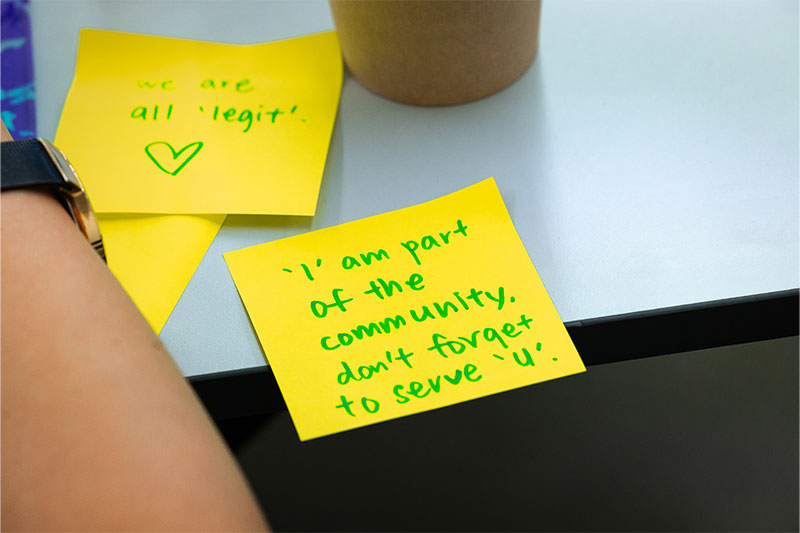
A participant’s discussion notes from the Empowering Communities Through Co-created Neighbourhood Trails workshop session, held on the first day of the ArtsWok Learning Forum. Photo by Zinkie Aw.
At the personal level, artists can consider documenting the scope of what they do, how much time is spent, and the outcomes of these activities. The aim here is not to eschew the aesthetic, speculative and imaginative for the productive or pragmatic. More so, it is to identify how these dissonant desires may actually converge or blend in favour of the community’s goals. Furthermore, this documentation can be a form of annotating and externalising one’s feelings about one’s process, choices, priorities, and such. As an artist and writer myself, I would recommend artists find their own creative ways of documenting their processes in audio, visual and textual forms that they find most appropriate to capture the complexity of the field. This could help towards building their own vocabulary of practice; a language that they can then share. To mitigate any possible confusion and to avoid overextending themselves, especially with organisations that are new to arts-based processes, artists need to be able to assess and clearly communicate the breadth and depths of what they can do and give of themselves within a given project.
At the organisational level, partner organisations could consider how they might provide further support and make space at the decision-making table for artists. This is especially crucial if the artist has already spent a length of time within a given community and is recognised as a member of it. It would also be a clear signal of recognising the multifaceted value of the arts and its place in the community. One way is for intermediary organisations to work jointly with artists on possible developmental goals, and then help others such as funding bodies recognise what artists can do with communities. Another important step would be for all parties to advocate and provide for fairer compensation, in recognition of the immersive and time-intensive aspects of community engagement; from facilitation, to reflection, to gathering in-depth feedback. Further, providing resources for research to explicate how particular creative approaches can help to reframe and revitalise existing ways of working in the field, and uncover sustainable paths forward.

A slide from Salty Xi Jie Ng’s sharing at the ArtsWok Learning Forum describing the artist’s multi-faceted role within a community. Photo by Zinkie Aw.
In sum, perhaps the key work of arts-based community development is best described as a field of constant and creative sense-making – highly engaged, activated, and manifested through individual as well as group work. From the examples shared in the first panel, one can see how an artist might play a critical role as facilitator. Beyond guiding participants through the art-making aspects, the skilled artist-facilitator foregrounds the use of the art process and of speculative, creative thinking to make space; to prompt deep conversations around crucial topics, not just with community members but between other partners involved in the work. It is a space where all who are vested are invited to draw on their subjective lived experiences and varied strengths. A shared space where a deep sense of recognition can be found, in attending to one another and in seeing what one can do for the other, in spite of ideological boundaries and differences. Here, artists working within communities in their distinct ways help to make sense, to nurture, to cultivate, to create, to dream. As such, artistic practice within a community project plays a reflective, speculative and generative role – to foster encounters that encourage imagination and dialogue. To invite all who are involved to recognise the particular conditions of a situation, and then speak to the potential of what else? and what’s next?
[1] Melissa G. Bublitz et al., ‘Collaborative Art: A Transformational Force within Communities’, in Journal of the Association for Consumer Research, Vol. 4, Issue 4: Everyday Consumer Aesthetics: Transformative Directions for Aesthetics in Everyday Life, ed. by Vanessa M. Patrick, et al. (Chicago: University of Chicago Press, 2019), pp. 305-445. ⌃
[2] Justin Lee et al., The Unique Value of the Arts in Community Development: A Case Study of ArtsWok Collaborative (Singapore: Institute of Policy Studies, 2020). ⌃
[3] ‘How Finding Your Strengths Can Address Community Challenges’ [n.d.]. Allkin.org.sg ⌃
[4] ‘Community Art’ [n.d.]. Tate.org.uk ⌃
[5] ‘Arts-based Community Development’ [n.d.]. Civicarts.org ⌃
[6] ‘Socially Engaged Practice’ [n.d.]. Tate.org.uk ⌃
[7] ‘Socially Engaged Art and Civic Art Practices’ [n.d.]. artsandplanning.mapc.org ⌃
[8] Rachel Clarke et al., ‘Situated Encounters with Socially Engaged Art in Community-based Design’ from DIS ’16: Proceedings of the 2016 ACM Conference on Designing Interactive Systems (New York: Association for Computing Machinery, 2016), pp. 521-532 ⌃
[9] Salty Xi Jie Ng, ‘Opening the Portals’ [31 July 2023]. Artswok.org.sg ⌃
[10] Maria-Rosario Jackson et al., Art and Culture in Communities: A Framework for Measurement (Washington, DC: The Urban Institute, 2003). ⌃
Cover image: ArtsWok Learning Forum participants in discussion at a workshop. Photo by Zinkie Aw.
All images provided by ArtsWok Collaborative unless specified otherwise.
About Regina De Rozario
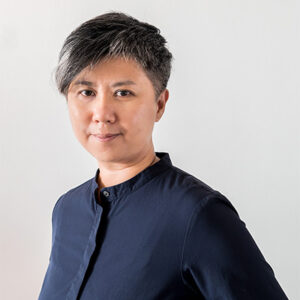
Regina is an artist, writer, and researcher investigating artistic practices in Singapore’s public spaces. A recipient of the National Arts Council Arts Scholarship for postgraduate studies, she is currently conducting her doctoral research at the National Institute of Education, Nanyang Technological University. She is also co-founder of Perception3, an interdisciplinary art duo based in Singapore. Their recent work includes commissioned installations for the Singapore Biennale (2016), iLight Singapore: Bicentennial Edition (2019), and the Singapore Night Festival (2022). As an adjunct educator, Regina is a supervisor with LASALLE College of the Arts’ MA Fine Arts programme, and a lecturer with the Nanyang Academy of Fine Arts’ BA (Hons) Fine Art programme where she teaches collective artistic practice and research methods.




